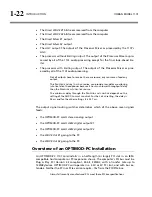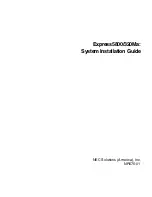
OPTIMOD-PC INTRODUCTION
1-35
All such algorithms operate by increasing the quantization noise in discrete fre-
quency bands. If not psychoacoustically masked by the program material, this noise
may be perceived as distortion, “gurgling,” phasiness, or other interference. Psycho-
acoustic calculations are used to ensure that the added noise is masked by the de-
sired program material and not heard. Cascading several stages of such processing
can raise the added quantization noise above the threshold of masking, such that it
is heard. In addition, there is at least one other mechanism that can cause the noise
to become audible at the radio. OPTIMOD-PC’s multiband limiter performs an “auto-
matic equalization” function that can radically change the frequency balance of the
program. This can cause noise that would otherwise have been masked to become
unmasked because the psychoacoustic masking conditions under which the masking
thresholds were originally computed have changed.
Accordingly, if you use lossy data reduction in the studio, you should use the highest
data rate possible. This maximizes the headroom between the added noise and the
threshold where it will be heard. In addition, you should minimize the number of
encode and decode cycles, because each cycle moves the added noise closer to the
threshold where the added noise is heard.
Interfacing to the Transmitter
Sync Input
In the DAB system, several programs are combined into one “ensemble multiplex.”
This requires synchronization of the sample rates applied to the transmitter. DTV
and HD Radio® also require synchronization. OPTIMOD-PC allows you to use either
of the AES3 inputs to accept “house sync,” which permits OPTIMOD-PC’s output to
be synchronized to a master sync generator. OPTIMOD-PC can also sync to a 1x word
clock or a 10 MHz reference applied to the sync input. OPTIMOD-PC’s AES3 and
WAVE outputs will be synchronized to the sync input selected via the
D
IGITAL
C
LOCK
R
EFERENCE
control. Because OPTIMOD-PC’s digital inputs are equipped with sample
rate converters, locking the output sample rate to the house sync reference allows
asynchronous digital inputs to be applied to OPTIMOD-PC’s AES3 inputs while ensur-
ing that OPTIMOD-PC’s output is in sync with the master sync generator. See also
page 1-29:
Genlocking OPTIMOD-PC Cards to a Reference Sample Frequency
Sample Rate and Audio Bandwidth
Most DAB audio is at 48 kHz sample rate. However, AM HD Radio operates at 32
kHz, requiring 15 kHz audio bandwidth. The DAB system offers a 24 kHz sample rate
option, requiring 10 kHz audio bandwidth.
OPTIMOD-PC’s bandwidth can be adjusted from 10 kHz to 20 kHz to provide cor-
rectly anti-aliased audio for any of these systems. If any anti-aliasing filters following
OPTIMOD-PC’s output are phase-linear and have integer-sample time delays, these
filters will pass the band-limited OPTIMOD-PC output without introducing overshoot
because they remove no further spectrum and do not cause their output samples to
become asynchronous with the peak-controlled samples at OPTIMOD-PC’s output.
OPTIMOD-PC always operates at 48 kHz sample rate internally. This rate can be
locked to any sync input; otherwise, it will synchronize to the card’s internal crystal
Содержание Optimod-PC 1101
Страница 4: ......
Страница 14: ......
Страница 121: ...OPTIMOD PC OPERATION 3 1 Section 3 Operation Figure 3 1 The OPTIMOD PC Control Application...
Страница 192: ...3 72 OPERATION ORBAN MODEL 1101...
Страница 204: ......
Страница 210: ......
Страница 212: ...5 2 UNINSTALLATION ORBAN MODEL 1101...
Страница 236: ......
















































